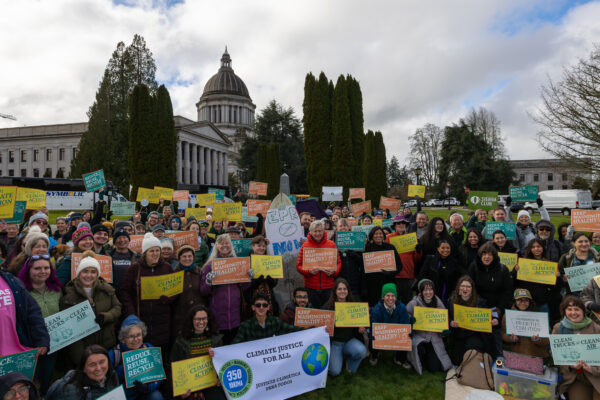At Washington Conservation Action, we recognize how Indigenous cultures have long centered community and have stewarded the landscapes they inhabit since time immemorial. This is not by accident. It’s because many of the ideas and practices embraced by Western culture as “environmental” in the last several decades are not new. In November, Native American Heritage Month, we should take a moment to remember that environmental stewardship has been practiced by Indigenous peoples for hundreds and thousands of years.
And treaties between Tribes and the United States, while used to justify hoarding lands from Indigenous peoples, could also be considered some of the first environmental protection laws.
For instance, the Treaty of Point Elliot (1855), signed by Seattle and more than six dozen leaders of Salish Tribes, guarantees that the Tribes have “the right of taking fish at usual and accustomed grounds and stations.” This in effect means that those lands and waters must be maintained in order to honor the treaties.
On the Eastside, the Treaty of Walla Walla, signed the same year, likewise guarantees, “That the exclusive right of taking fish in the streams running through and bordering said reservation is hereby secured to said Indians, and at all other usual and accustomed stations in common with citizens of the United States, and of erecting suitable buildings for curing the same; the privilege of hunting, gathering roots and berries and pasturing their stock on unclaimed lands in common with citizens, is also secured to them.”
In 1974, the Boldt decision of the U.S. District Court of the Western District of Washington affirmed these fishing rights, which had been ignored for decades. The decision also held that state and federal governments must respect the terms of treaties with Tribes. This encouraged Tribes across the country to fight for their rights. That, in turn, has led to the environmental protection of many areas, because the “usual and accustomed areas” to fish and gather reach far beyond the limits of reservations. And fishing and gathering is predicated on healthy ecosystems.
This forms the legal basis for Tribes to object to projects that damage ecosystems, such as a pumped storage energy facility siting proposed eight miles south of the town of Goldendale in south-central Washington. The facility would destroy an area called Push-pum or “mother of all roots” by the Yakama Nation. This landscape occupies a central place in Yakama religion and ceremony and has several important cultural sites. The plants that grow there are used by the Tribe to treat illness in the body and spirit. For countless generations, these plants have served as poultice, tea, bandages, pacifiers, drums, needles, rope, nets, and food.
WCA has joined with the Yakama Nation, and dozens of other Tribes and environmental organizations to oppose this project. While it would store energy created by wind and solar generators, it would also destroy a landscape sacred to the Yakama since time immemorial. And the Yakama have been taking care of this land for millennia. If it harms Tribes, it’s not clean energy. You can find out more about this issue here.
We should remember that Tribes have been centering “environmental” concepts for a very long time, here are other examples of this:
Recycling and public sanitation
When Hernan Cortes and his soldiers first saw the Aztec city of Tenochtitlan, now Mexico City, in 1521, they were blown away by its grandeur, size and cleanliness. The city had approximately 200,000 inhabitants. It was the largest city in the Americas, and one of the largest in the world, bigger than any European city of the time. The Aztecs had complex and intensive sanitation and recycling systems, overseen by an official bureaucracy. Dumping waste or littering was illegal. Organic and human waste was used to fertilize crops grown in the city’s network of artificial islands, or to tan leather. Urine was recycled, used to fix dyes on fabrics. Flammable materials, such as old textiles, were repurposed to be burned in public spaces at night. Wastefulness was not tolerated: Nobles and other elites, expected to be role models, suffered stiffer penalties if they violated sanitation laws.
Biodiversity
Lands inhabited by Indigenous peoples contain 80 percent of the planet’s remaining biodiversity. If your community occupies a landscape for millennia, your people come to know the stories, values and the purpose of thousands of species. You understand how different habitats complement each other. You don’t see land as simply a range for animals or a plot for agriculture but as a living being – a relative – something that deserves respect and reverence. For instance, a 2019 UN report found that Indigenous gardens preserved biodiversity by combining both wild and domestic species, letting them thrive together. In some cases, an Indigenous garden might have 300 to 500 species growing in it.
Ecosystem services
Most, if not all, Native cultures in some way deeply acknowledge that we are dependent upon nature–we are nature. The air we breathe, the water we drink, the food we eat—all those things depend upon healthy ecosystems.
The dominant attitude in Western culture over the last several hundred years has viewed nature as either an opponent, or as something to be used for human benefit. Something separate from humans. In contrast, many Native traditions emphasize that we should respect the natural world that sustains us, never taking too much, and giving back when possible because we too are nature
For instance, the Tulalip give thanks to the mountain before they gather its resources. If picking huckleberries, they never pick all the berries off a bush. As they pick, they step lightly. The idea is that after they’ve harvested the berries, no one should be able to tell that they were there.
Rights of nature
“Rights of Nature” is a growing worldwide movement calling for a recognition that ecosystems have a right to exist, thrive and evolve in natural cycles.
As the Global Alliance for Rights of Nature has stated, “Until we embrace the fundamental rights of Tribal Nations to set legal frameworks that sustain all life, governments and major corporations will continue to harm ecosystems and erode tribal sovereignty. Rights of Nature efforts in part seek to end ‘sacrifice zones,’ the areas given over to the most hazardous activities nearly always situated where low-income, communities of color and Indigenous people live.”
These ideas are deeply embedded in many Native cultures. For instance, the Lummi people believe that it is their sacred obligation to care for their lands, “the air, waters, and all living things on Earth, the trees, the salmon, the winged and two legged.”
In April, the City of Seattle settled one of the first “rights of nature” cases filed in the United States. That case, brought in 2022 by the Sauk-Suiattle Tribe, with salmon as a plaintiff, sought a declaratory judgment recognizing the legal rights of salmon, The suit held that the lack of fish passage measures at the City’s dams harmed the Tribe’s culture and traditions, religion, and Treaty rights. Seattle licenses several Skagit River hydroelectric dams that feed power to Seattle. As part of the settlement, Seattle will include a fish passage program when it renews those leases.



